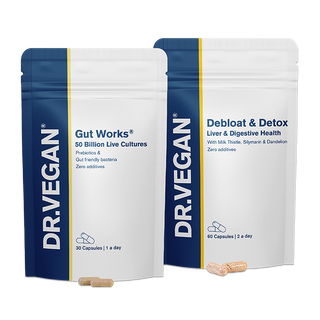What are gallstones?

The prevalence of gallstones increases with age and affects 10–15% of the adult population, but not all people have symptoms. Some people with gallstones can stay symptom free whilst others may experience sharp, intense pain, or other health complications. Here we explain gallstones, how they form and how to treat them.
What are gallstones?
Gallstones develop when the gallbladder is not emptying properly. This may be due to:
- Too much bilirubin causing ‘pigment stones’.
- Too much cholesterol, known as 'cholesterol stones'. These can also be related to an under active thyroid gland which is not related to high cholesterol, but instead by a concentration of cholesterol in the gallbladder.
- Dehydration.
- Toxin overload in the body.
- A diet high in junk food, or a low-fat diet.
The most common type of gallstone tends to be a crystalline mass of bilirubin, cholesterol and calcium salts. Gallstones can vary in size, ranging from the size of a small marble to the size of a golf ball. You could have just one or many.
An adequate amount of fat is needed to trigger the release of bile at mealtimes. If this doesn’t happen, then bile stagnates and becomes sludgy. As a result, adopting a low-fat diet when diagnosed with gallstones only serves to exacerbate the problem.
You may be interested in learning more about the gallbladder and signs of gallbladder issues or our guide to diet and lifestyle changes after gallbladder removal.
The thyroid-gallbladder connection
Bile is released into the bile duct and then flows into the duodenum (small intestine) via a small muscle at the end of the common bile duct and pancreatic duct, known as the Sphincter of Oddi. Thyroxine (T4) relaxes the Sphincter of Oddi, allowing bile to flow through to the duodenum. If there is insufficient T4, the sphincter will not be able to relax enough. This impedes the flow of bile out of the gallbladder, allowing bile to accumulate and saturate to form sludge and, eventually, gallstones.
Even if you have not yet been diagnosed with hypothyroidism but your T4 is at the low end of the reference range, you may have an increased risk of stones in the bile duct.
Daily Multi-Vitamin

If you have known gallbladder issues or a history of gallstones, it's advisable to get your thyroid function tested. To give you a more accurate sense of your thyroid function, ideally include thyroid antibodies and thyroid receptor antibodies in your test (as well as thyroid stimulating hormone (TSH), T3, and T4). Not only is T4 needed to help release bile, but bile is also needed to convert T4, the inactive thyroid hormone, into the active form T3, so it is part of a vicious cycle.
Low thyroid hormone levels slows down cholesterol metabolism in the liver (often found in many gallstones), leading to an increase in bile and cholesterol that saturates the liver and gallbladder.
Insufficient thyroid hormone (T4) slows down the contraction of the gallbladder, thereby impairing the filling of the gallbladder and the release of bile. This can lead to the formation of stones in the gallbladder and/or the bile duct.
If you have low thyroid function, a good plan would be to work with a naturopathic nutritionist who understands thyroid issues and can help you improve and effectively support thyroid function. Discover our expert nutritionist tips for your thyroid:
Symptoms of gallstones
As gallstones vary in size and number, you may not experience any symptoms, however common symptoms of gallstones are:
- Fever
- Chills
- Pain - abdominal pain or pain in your right shoulder
- Nausea
- Jaundice
- Diarrhoea
When should gallstones be removed?
You don't always have to get gallstones removed, it depends on whether the stones are blocking any ducts, causing health complications or infections.
Treatments for gallstones
There are a number of treatment options that can be offered when you have developed gallstones. The gallbladder can be removed, often via ‘keyhole’ surgery. The stones can be removed from the gallbladder using a procedure called 'endoscopic retrograde cholangio-pancreatography', otherwise known as ERCP. If your gallstones are small and don't contain calcium, it may be possible to take a medication called 'ursodeoxycholic acid tablets' to dissolve them.
Another method for treating gallstones is known as 'extracorporeal shockwave lithotripsy' (ESWL). The aim of ESWL is to break the stones into pieces small enough to pass out of the cystic duct and the sphincter of Oddi, where their maximum size is about 5mm. This is accompanied by oral bile salt therapy given after the procedure, and lithotripsy repeated after 4-6 weeks if fragments larger than 5mm remain.
Discover our range of award-winning vegan supplements and probiotics.
You may also enjoy reading:
- Should you take probiotics after antibiotics?
- Difference between soluble & insoluble fibre
- Latest gut health research: IBS causes & symptoms revealed
- Acid reflux? Best 3 foods to eat and avoid
- Do I need to take a fibre supplement?
- Why fibre in your diet is essential
Want to hear more from our nutritionists? Sign up to our email newsletter for insights and exclusive offers:


















